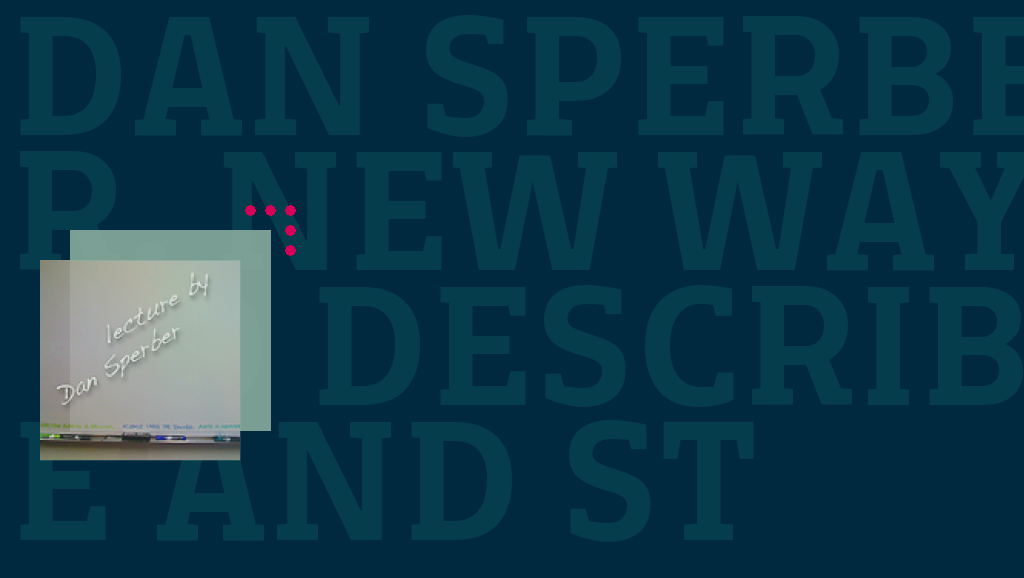by Angela Simone.
As if it were recently invented, the word interdisciplinarity can ever more regularly be heard in discussions both outside and within academia. After years of pushing towards an ever more refined specialization where the order of the day was to find space in a niche of knowledge that one could call either their own, or share with a few others in the world, the dictate has changed. Contaminate, mix, exchange concepts and methods, key ideas and practices with others that are close in terms of fields of study but distant in terms of practice and conceptually distant but contiguous in their methodologies. These are the imperatives upon which thought (and action-research) into the society in which we live seem to lean.
Through his long academic career Dan Sperber, anthropologist by trade but scientist of cognition by vocation, is the incarnation of this transformation. Interdisciplinarity or transdisciplinarity, or as it is often referred to today cross disciplinary has become one of the characteristics of his incessant work into the comprehension of individual questioning, starting from our closest essence, the mind. The mind and its mechanisms as a key to explaining how cultural contents can construct us, become spread and differentiate us. A new cognitive anthropology that aims to communicate with all those that study the mind from different perspectives in order not only to work together towards a common objective but also to take on ‘materials and methods’, language, criteria and problems to create a single shared field.
At the end of the 1980’s Sperber started his long walk towards a change of paradigm together with a small number of anthropologist colleagues, arming themselves with the work of Noam Chomsky and psychologists of development and eventually constructing a new approach, in continuous evolution, that transcends the barriers and borders of disciplines and that cannot just be called anthropology, or philosophy, or psychology, or linguistics or neuroscience.
The road is not always easy to follow and the mistrust between academics from different disciplines and the battle for the supremacy of one approach over another became obstacles to constantly overcome. Even the use of the same words in different fields (such as ‘culture’ in anthropology and psychology) creates potential rifts and misunderstandings that must be resolved in order to create an environment that is truly mixed. But the small number of results that were achieved at the beginning through a truly trans-disciplinary approach signal the origin of cognitive sciences as an open sector that studies the mind and continuously accepts new approaches and points of view.
For Sperber interdisciplinarity became (as it regularly becomes for all of those that live for the study of the cognitive sciences) a way of being and of conducting research in order to explore the foundations of the social and cognitive sciences, and he has published his works in journals from all of the disciplines represented in his work: anthropology, linguistics, philosophy and experimental psychology. On the other hand, as Sperber himself affirms, the fragmentation between academic disciplines is not the reflection of ‘natural divisions of levels of reality’ but is a simple historical-social construction expressed at the time the modern universities were founded. It is therefore imaginable that the passage of time would mutate (as is already happening), the compartmentalization that we know, fueled ever more by the massive effect brought by Internet use. Spreading out from the political sciences that were the first to accept the interdisciplinary approach (often more in intention than in concrete facts notes Sperber), a vision that holds a greater number of points of analysis is the means to interpret individuals and the modern community.
Sperber’s vision therefore is a spur to look at the present in order to see the future, to innovate the ways of describing and structuring new societies. But above all it is an example of how communication and the integration of different forms and structures, through different methodologies and languages (both possible and at the same time necessary and no longer avoidable), for those who analyze and propose actions for a society permanently immersed in contact with science and society.
————–
photo: Whiteboard Philosophy by thewind from Flickr (with our title)
















